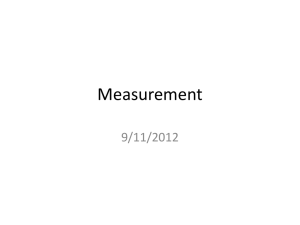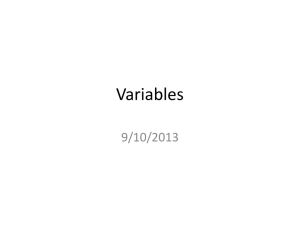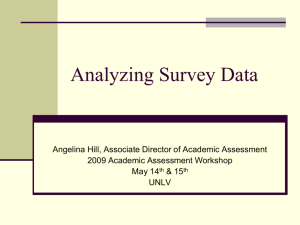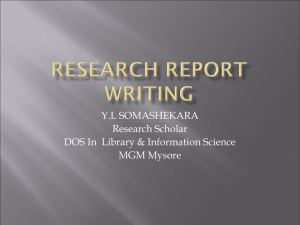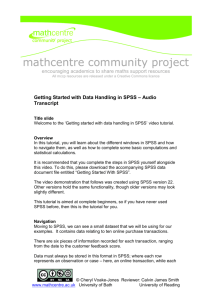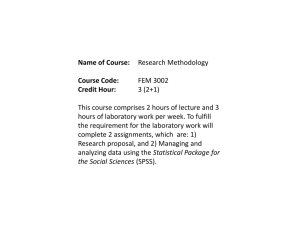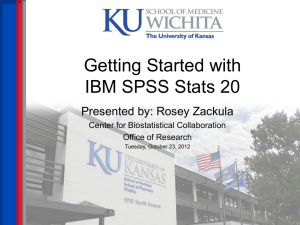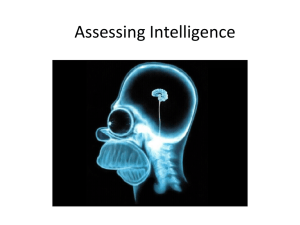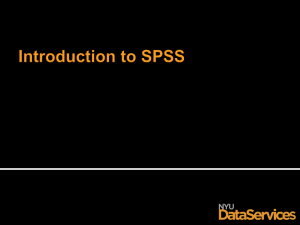Reliability and Validity
advertisement
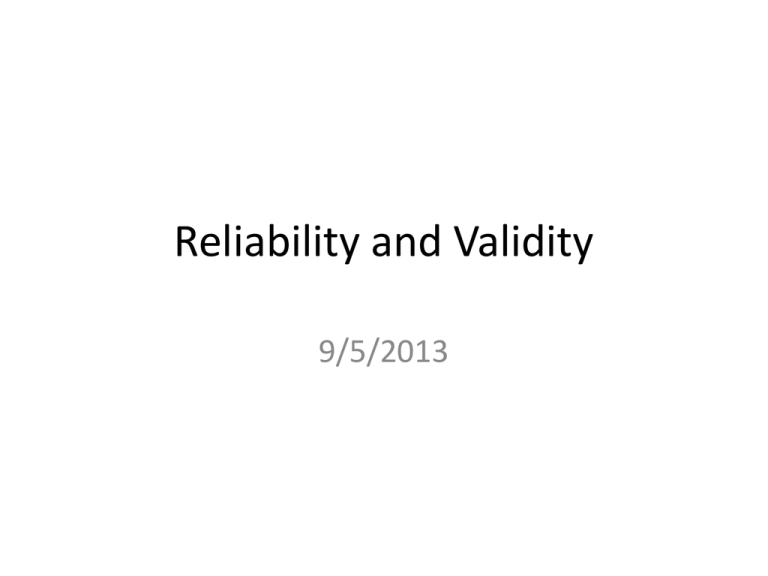
Reliability and Validity 9/5/2013 Readings • Chapter 3 Proposing Explanations, Framing Hypotheses, and Making Comparisons (Pollock) (pp.48-58) • Chapter 1 Introduction to SPSS (Pollock Workbook) Homework: Due 9/12 • Chapter 1 – Question 1 Parts A &B – Question 2 About the Homework • It must be turned in during class. • It cannot be emailed • It must appear on the workbook paper (original or a photocopy) • You cannot: OPPORTUNITIES TO DISCUSS COURSE CONTENT Office Hours For the Week • When – Monday 10-12:00 – Tuesday 8-12 – And by appointment Course Learning Objectives 1. students will achieve competency in conducting statistical data analysis using the SPSS software program. 2. Students will learn the basics of research design and be able to critically analyze the advantages and disadvantages of different types of design. RELIABILITY AND VALIDITY Measurement Validity • A measure is valid if it measures what it is supposed to measure • The measure and the concept correspond Operational Validity • The measure does what it says • This can be difficult to establish Face Validity • The simplest way to seek validity • The Measure looks good on its face • We ask People, use the literature • Problems? Content Validity • Using several measures of a concept to get at the whole concept • Good for multidimensional concepts (e.g. political participation) St. Edward’s Admissions • $50 Application fee • High School Transcript • SAT or ACT • Essay • Recommendation Form Trust in Government • • • • Trust the Federal Government Is the Government Run for the Benefit of All Do People in Government Waste Tax Money Are Government Officials Crooked Freedom House Index • 27 Questions A. Electoral process B. Political pluralism & participation C. Functioning of government D. Freedom of expression & belief E. Associational & organizational rights F. Rule of law G. Personal autonomy and individual rights The Misery Index LEED Building Leadership in Energy and Environmental Design Predictive Validity • Using a measure to predict a future outcome • This is very difficult in the social sciences The NFL Combines • 40-yard dash • Bench press • Vertical jump • Broad jump • 3 cone drill • Shuttle run Newsweek from 1978 The LSAT’s • The LSAT is designed to measure skills that are considered essential for success in law school • The LSAT is a strong predictor of first-year law school grades • What doesn’t it measure? RELIABILITY Measurement Reliability • A measurement will provide the same results upon repeated tests • The more consistent the results… the more reliable the measure Random Error • Outside of the control of the researcher – Outlier case – People’s feelings – weather • Large sample sizes reduce this Bad Weather and Turnout Non-Random Error • Systemic Researcher Error – – – – – Poor design Lazy administration Intentional error Small samples carelessness • This will distort the measure of a concept Non-Random Error Ensuring Reliability • Good Definitions and unambiguous questions • Clear Directions • Making results and information available to other researchers Methods for ensuring Reliability • Alternative forms technique • Test-Retest A measure can be reliable without being valid, but a measure cannot be valid without being reliable! A way of getting content validity INDEXES AND SCALES Why create a scale/index? • To form a composite measure of a complex phenomenon by using two or more items • Get at all facets • Simplify our data Examples • GPA Likert Scale • A common way of creating a scale • Advantages • Disadvantages Guttman Scaling • Employs a series of items to produce a score for respondents • Ordering questions that become harder to agree with • Advantages and disadvantages Guttman Scale SPSS Statistical Package for the Social Sciences What is a statistical package • Popular Versions – – – – SPSS SAS R Stata Getting SPSS Don’t • Purchase a student version – Limited functions – Limited variables • Searching the internet for a “free version” – You might get a virus – The Russians will steal your identity (exception fallacy). Do • Use it on the machines on campus- free! • Consider purchasing a 6month license (52.00 + 4.99 download fee) How to Open Data files • Data Files on the Pollack CD • GSS2008.SAV- the 2008 General Social Survey Dataset – n=2023 – 301 variables • NES2008.SAV- the National Election Study from 2008. n=2323 – 302 variables • STATES.SAV- aggregate level data for the 50 States. N=50 – 82 Variables • WORLD.SAV- aggregate level data for the nations of the world. n=191 – 69 Variables SPSS uses 2 windows • Data Editor Window – is used to define and enter your data and to perform statistical procedures. – very spread-sheet like – .sav extension • The Output Window – this is where results of statistical tests appear – This opens when you run your first test – .spv extension HOW SPSS WORKS It is like a spreadsheet • In Variable View – You define your parameters – Give variables names – Operationalize variables • We will not do a lot of this Names and Labels Name • how the label appears at the top of the column (like the first row in excel) • you cant use dashes, special characters or start with numbers • These should represent the variable Labels • A longer definition of the variable • These describe the actual variable Value Labels • This shows how variables are operationalized • Value= the numeric value given to a category • Label= the attribute of the concept In Data View • You type in raw data • It looks very much like Excel • Rows= cases • Columns= Variables How Things are Displayed Edit • Options • Display names • Alphabetical I Like Values and Labels Variables Exiting SPSS • If you changed the actual dataset you must save it • If you ran any statistics, you must save these as well
